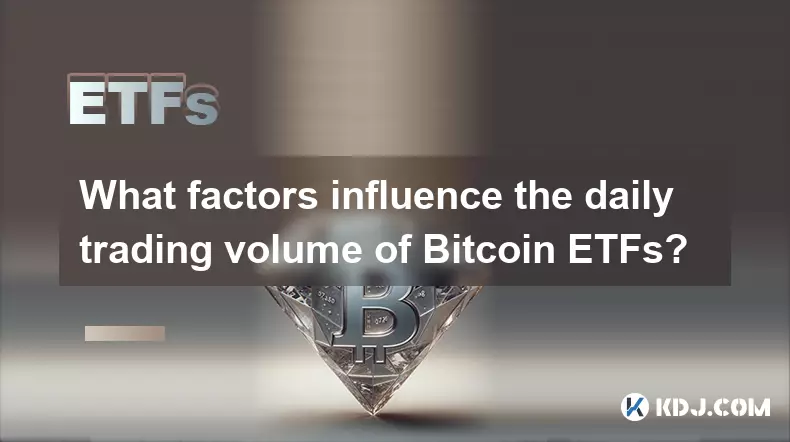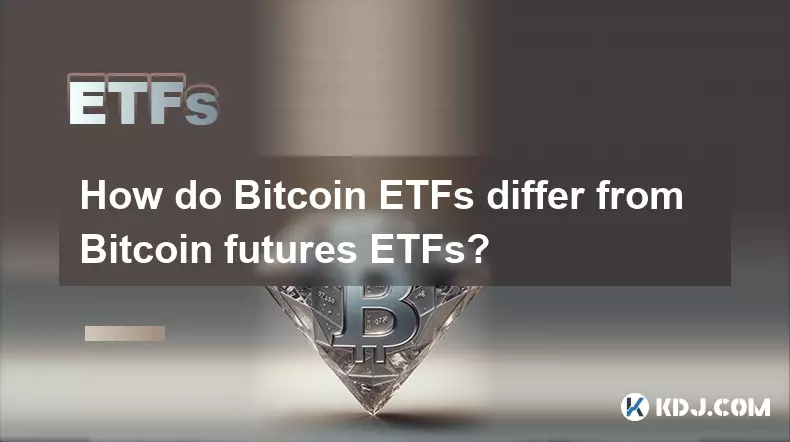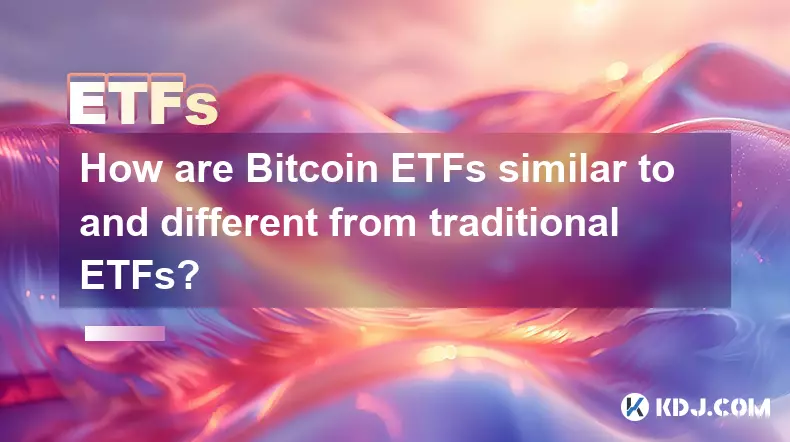-
 bitcoin
bitcoin $109667.069529 USD
-3.03% -
 ethereum
ethereum $3936.685804 USD
-4.07% -
 tether
tether $1.000493 USD
0.01% -
 xrp
xrp $2.771823 USD
-4.74% -
 bnb
bnb $957.805027 USD
-5.34% -
 solana
solana $196.735100 USD
-6.68% -
 usd-coin
usd-coin $0.999727 USD
-0.01% -
 dogecoin
dogecoin $0.227355 USD
-5.12% -
 tron
tron $0.335205 USD
-0.81% -
 cardano
cardano $0.779256 USD
-3.59% -
 ethena-usde
ethena-usde $0.999900 USD
-0.06% -
 hyperliquid
hyperliquid $42.492095 USD
-6.61% -
 chainlink
chainlink $20.501853 USD
-4.34% -
 avalanche
avalanche $28.952606 USD
-11.21% -
 stellar
stellar $0.356038 USD
-3.93%
What factors influence the daily trading volume of Bitcoin ETFs?
Regulatory shifts, macroeconomic trends, and on-chain activity heavily influence Bitcoin ETF trading volume, while sentiment and technical factors drive short-term fluctuations.
Sep 23, 2025 at 07:18 am

Market Sentiment and Investor Confidence
1. The perception of economic stability heavily affects how investors approach Bitcoin ETFs. When macroeconomic indicators suggest uncertainty, such as inflation spikes or banking sector stress, capital tends to flow into Bitcoin ETFs as a hedge.
2. Media coverage and public narratives around cryptocurrency regulations or adoption can shift sentiment rapidly. Positive headlines about institutional uptake or government endorsements often lead to increased buying pressure.
Negative sentiment triggered by regulatory crackdowns or security breaches in the crypto space causes immediate sell-offs, directly reducing ETF trading volume.3. Social media trends and influencer commentary also play a role, especially among retail investors who follow sentiment-driven strategies when allocating funds to Bitcoin ETFs.
Liquidity and Underlying Bitcoin Movement
1. The availability of Bitcoin in the hands of institutions that support ETF products influences how smoothly shares can be created or redeemed. Limited liquidity in spot markets may constrain ETF issuance, affecting trading activity.
2. Large movements of Bitcoin on-chain, such as transfers from long-term holders to exchanges, signal potential shifts in supply dynamics, prompting traders to adjust ETF positions accordingly.
When major wallets move substantial BTC volumes, ETF trading often surges as market participants anticipate price volatility and position themselves ahead of expected moves.3. Arbitrage opportunities between spot Bitcoin prices and ETF share values drive high-frequency trading activity, which contributes significantly to daily volume fluctuations.
Regulatory Environment and Institutional Participation
1. Announcements from financial regulators regarding approval extensions, compliance requirements, or tax treatment of crypto ETFs have immediate impacts on trading behavior.
2. Countries permitting pension funds or insurance companies to allocate capital to Bitcoin ETFs witness sharp increases in trading volume due to inflows from large institutional pools.
Restrictive policies, such as trading limits or reporting mandates, tend to suppress participation, particularly from hedge funds and asset managers sensitive to compliance overhead.3. Regulatory clarity in major markets like the U.S. or EU sets precedents that influence global investor confidence, leading to synchronized volume changes across multiple ETF platforms.
Technical and Platform-Related Factors
1. Trading infrastructure quality, including order book depth and execution speed on platforms listing Bitcoin ETFs, determines how efficiently trades are processed during peak demand periods.
2. Integration with algorithmic trading systems allows automated strategies to respond to price signals, amplifying volume during technical breakouts or breakdowns.
Exchange outages or API disruptions can halt trading momentarily, causing volume to drop sharply even if underlying demand remains strong.3. Availability of margin trading and options contracts tied to Bitcoin ETFs expands the range of strategies available, encouraging more active participation and higher turnover rates.
Frequently Asked Questions
How do Bitcoin price swings affect ETF trading volume?Volatility in Bitcoin’s spot price typically leads to higher ETF trading volume. Sharp price increases attract momentum traders, while sudden drops prompt hedging and rebalancing activities through ETF instruments.
Do seasonal patterns impact Bitcoin ETF volume?Yes, historical data shows elevated trading activity during certain months, often linked to fiscal year-end portfolio adjustments, tax seasons, or recurring macroeconomic events like central bank meetings.
Can geopolitical tensions influence Bitcoin ETF trading?Geopolitical instability often drives investors toward alternative assets. Bitcoin ETFs see increased volume during such periods as they offer a regulated entry point to gain exposure without holding actual cryptocurrency.
What role do authorized participants play in ETF volume?Authorized participants manage the creation and redemption of ETF shares. Their activity ensures alignment between the ETF price and the net asset value, and their trading operations contribute substantially to overall volume metrics.
Disclaimer:info@kdj.com
The information provided is not trading advice. kdj.com does not assume any responsibility for any investments made based on the information provided in this article. Cryptocurrencies are highly volatile and it is highly recommended that you invest with caution after thorough research!
If you believe that the content used on this website infringes your copyright, please contact us immediately (info@kdj.com) and we will delete it promptly.
- Hashdex, Crypto ETFs, XRP & Solana: A New Era for Digital Asset Investing
- 2025-09-26 18:25:12
- Crypto Market Slowdown? Year-End Rally Still in Play!
- 2025-09-26 18:25:12
- XRP, RLUSD, and the Derivatives Market: A New York Minute on Crypto's Next Big Thing
- 2025-09-26 18:45:15
- Bitcoin Price Under Pressure: Is $105,000 Still in Play?
- 2025-09-26 19:05:14
- Pepeto's Presale Surge: Riding the PEPE Success Wave?
- 2025-09-26 19:05:14
- Pepeto vs. Shiba Inu vs. PEPE: The Next Meme Coin Millionaire Maker?
- 2025-09-26 19:10:01
Related knowledge

Will Bitcoin ETFs affect Bitcoin's decentralized nature?
Sep 24,2025 at 02:00am
Impact of Bitcoin ETFs on Market Accessibility1. Bitcoin ETFs have significantly lowered the barrier to entry for traditional investors who may not be...

Which exchanges list Bitcoin ETFs?
Sep 26,2025 at 03:18am
Major Cryptocurrency Exchanges Offering Bitcoin ETFs1. The landscape of digital asset trading has evolved significantly with the introduction of Bitco...

Is the volatility of Bitcoin ETFs consistent with Bitcoin?
Sep 26,2025 at 01:18am
Bitcoin ETFs and Their Relationship to Bitcoin Price Movements1. Bitcoin ETFs are financial instruments designed to mirror the price of Bitcoin withou...

What factors influence the daily trading volume of Bitcoin ETFs?
Sep 23,2025 at 07:18am
Market Sentiment and Investor Confidence1. The perception of economic stability heavily affects how investors approach Bitcoin ETFs. When macroeconomi...

How do Bitcoin ETFs differ from Bitcoin futures ETFs?
Sep 23,2025 at 09:37pm
Differences Between Bitcoin ETFs and Bitcoin Futures ETFs 1. A Bitcoin ETF directly holds actual Bitcoin as its underlying asset, allowing investors e...

How are Bitcoin ETFs similar to and different from traditional ETFs?
Sep 25,2025 at 01:19am
Similarities Between Bitcoin ETFs and Traditional ETFs1. Both Bitcoin ETFs and traditional ETFs are traded on established financial exchanges, allowin...

Will Bitcoin ETFs affect Bitcoin's decentralized nature?
Sep 24,2025 at 02:00am
Impact of Bitcoin ETFs on Market Accessibility1. Bitcoin ETFs have significantly lowered the barrier to entry for traditional investors who may not be...

Which exchanges list Bitcoin ETFs?
Sep 26,2025 at 03:18am
Major Cryptocurrency Exchanges Offering Bitcoin ETFs1. The landscape of digital asset trading has evolved significantly with the introduction of Bitco...

Is the volatility of Bitcoin ETFs consistent with Bitcoin?
Sep 26,2025 at 01:18am
Bitcoin ETFs and Their Relationship to Bitcoin Price Movements1. Bitcoin ETFs are financial instruments designed to mirror the price of Bitcoin withou...

What factors influence the daily trading volume of Bitcoin ETFs?
Sep 23,2025 at 07:18am
Market Sentiment and Investor Confidence1. The perception of economic stability heavily affects how investors approach Bitcoin ETFs. When macroeconomi...

How do Bitcoin ETFs differ from Bitcoin futures ETFs?
Sep 23,2025 at 09:37pm
Differences Between Bitcoin ETFs and Bitcoin Futures ETFs 1. A Bitcoin ETF directly holds actual Bitcoin as its underlying asset, allowing investors e...

How are Bitcoin ETFs similar to and different from traditional ETFs?
Sep 25,2025 at 01:19am
Similarities Between Bitcoin ETFs and Traditional ETFs1. Both Bitcoin ETFs and traditional ETFs are traded on established financial exchanges, allowin...
See all articles










































































